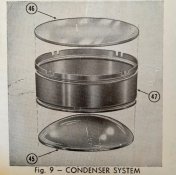Good to hear that these little enlargers are worth using. Reading from the above link provided the 279 is a diffusing condenser. I have no idea what that means..
There are a couple of methods of delivering light to a negative.
From Wikipedia
An enlarger is a specialized transparency projector used to produce photographic prints from film or glass negatives using the gelatin silver process, or from transparencies.
Contents [hide]
1 Construction
2 Types of Enlarger
3 Enlarger physical arrangements
4 Principles of operation
5 Paper processing
6 Automated print machines
7 Advantages
8 Image enlargement limits
9 Manufacturers
10 See also
11 References
Construction[edit]
All enlargers consist of a light source, normally an incandescent light bulb, a condenser or translucent screen to provide even illumination, a holder for the negative or transparency, and a specialized lens for projection. The light passes through a film holder, which holds the exposed and developed photographic negative or transparency.
Prints made with an enlarger are called enlargements. Typically, enlargers are used in a darkroom, an enclosed space from which extraneous light may be excluded; some commercial enlargers have an integral dark box so that they can be used in a light-filled room.
Types of Enlarger[edit]
"Photographic Enlarger.
A condenser enlarger consists of a light source, a condensing lens, a holder for the negative and a projecting lens. The condenser provides even illumination to the negative beneath it.
A diffuser enlarger's light source is diffused by translucent glass or plastic, providing even illumination for the film.
Condenser enlargers produce higher contrast than diffusers because light is scattered from its path by the negative's image silver; this is called the Callier Effect. The condenser's increased contrast emphasises any negative defects, such as dirt and scratches, and image grain.
Diffuser enlargers produce an image of the same contrast as a contact print from the negative.[1]
Dedicated color enlargers contain an adjustable filter mechanism - the color head - between the light source and the negative, enabling the user to control the amount of cyan, magenta and yellow light reaching the negative. Other models have a drawer where cut filters can be inserted into the light path. These enlargers can also be used with variable-contrast monochrome papers.
Digital enlargers project an image from an LCD screen at the film plane, to produce a photographic enlargement"
There are different types of condenser enlargers as well as diffusion enlargers. Your federal is a typical of a diffusion enlarger, a white semi translucent glass plate scatters the light from the blub. Very simple, somewhat slower than a condenser enlarger, shows less dust, lower contrast.








 !
!



